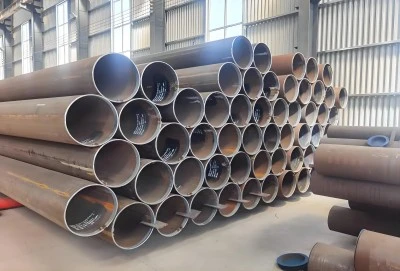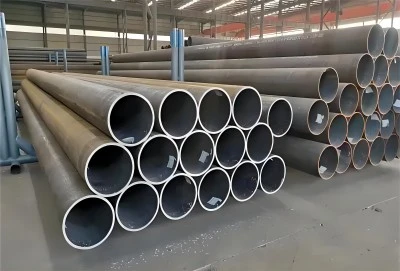The oil and gas industry relies heavily on robust pipeline systems for efficient transportation of resources across vast distances. Among the various types of pipes used, API 5L X65 pipes have gained significant popularity due to their exceptional strength and durability. However, when it comes to large-diameter X65 pipes, the transportation and installation process presents unique challenges that require careful planning and execution. In this comprehensive guide, we'll explore the technical hurdles faced by engineers and construction teams when dealing with these massive steel structures.
|
|
|
Overcoming Logistical Issues in Transporting Large-Diameter X65 Steel Pipes
The transportation of large-diameter X65 pipes is a complex endeavor that demands meticulous planning and specialized equipment. These pipes, often measuring up to 80 inches in diameter, pose significant logistical challenges that can impact project timelines and costs.
1.Route Planning and Permits
One of the primary concerns when transporting large-diameter X65 pipes is route planning. The sheer size of these pipes often necessitates the use of unconventional transportation routes that can accommodate oversized loads. This may involve:
- Identifying roads with sufficient width and load-bearing capacity
- Planning for potential obstacles such as low bridges or narrow tunnels
- Obtaining special permits from local authorities for oversized cargo
- Coordinating with utility companies to temporarily remove overhead lines if necessary
The process of securing permits can be time-consuming and may require negotiations with multiple jurisdictions, especially for long-distance transportation across state or national borders.
2.Specialized Transportation Equipment
Transporting large-diameter X65 pipes requires the use of specialized equipment designed to handle heavy, oversized loads. Some of the key transportation methods include:
- Custom-built trailers with multiple axles to distribute weight evenly
- Self-propelled modular transporters (SPMTs) for maximum maneuverability
- Barges for water transportation, particularly useful for coastal or offshore projects
- Rail transportation for long-distance inland routes
Each of these methods comes with its own set of challenges, from ensuring proper load securement to managing the logistics of intermodal transfers.
3.Environmental Considerations
The transportation of large-diameter X65 pipes must also take into account environmental factors that could impact the integrity of the pipes or pose risks during transit. These considerations include:
- Protection against corrosion during long-term storage or transportation
- Mitigation of temperature-related expansion and contraction
- Safeguarding against physical damage from impacts or excessive vibration
- Ensuring proper support to prevent deformation of the pipe's circular cross-section
Implementing effective protective measures is crucial to maintain the quality and performance characteristics of the X65 steel pipes throughout the transportation process.
Handling and Laying Techniques for Installing Large-Diameter X65 Pipelines
Once the large-diameter X65 pipes have been successfully transported to the project site, the next challenge lies in their installation. The handling and laying of these massive pipes require specialized techniques and equipment to ensure proper placement and long-term performance.
1.Site Preparation and Trench Excavation
Before the pipes can be laid, extensive site preparation is necessary. This involves:
- Surveying and marking the pipeline route
- Clearing vegetation and obstacles along the right-of-way
- Excavating trenches to the required depth and width
- Ensuring proper trench bedding to support the weight of the pipe
The trench design must account for the pipe's diameter, wall thickness, and the soil conditions to prevent settling or shifting after installation.
2.Pipe Handling and Positioning
Moving and positioning large-diameter X65 pipes requires heavy-duty equipment and precise control. Common handling methods include:
- Side boom tractors equipped with specialized lifting devices
- Vacuum lifters for damage-free handling of coated pipes
- Pipe laying barges for offshore or river crossing installations
- Hydraulic pipe layers for precise positioning in challenging terrains
Operators must be highly skilled to maneuver these massive pipes into place without causing damage or compromising safety.
3.Welding and Joint Integrity
The integrity of a pipeline system depends heavily on the quality of its welds. For large-diameter X65 pipes, welding presents unique challenges:
- Ensuring consistent weld quality around the entire circumference of the pipe
- Managing heat input to prevent distortion or changes in the pipe's mechanical properties
- Implementing proper pre-heating and post-weld heat treatment procedures
- Conducting non-destructive testing (NDT) to verify weld integrity
Advanced welding techniques such as automated orbital welding systems are often employed to maintain consistency and efficiency in the welding process.
4.Cathodic Protection and Coating Systems
To ensure the longevity of large-diameter X65 pipes, robust corrosion protection systems are essential. This typically involves:
- Applying high-performance external coatings to prevent corrosion
- Installing cathodic protection systems to mitigate electrochemical corrosion
- Implementing internal coatings or linings for certain applications
- Conducting thorough coating inspections and repairs before backfilling
The selection and application of these protection systems must be carefully coordinated with the pipe handling and installation process to avoid damage.
Addressing Installation Risks and Quality Control in Large-Diameter X65 Pipeline Projects
The installation of large-diameter X65 pipelines comes with inherent risks that must be carefully managed to ensure project success and long-term pipeline integrity. Implementing robust quality control measures is crucial throughout the installation process.
1.Risk Assessment and Mitigation Strategies
Before and during installation, comprehensive risk assessments should be conducted to identify potential hazards and develop mitigation strategies. Key areas of focus include:
- Geotechnical risks such as soil instability or seismic activity
- Environmental risks including extreme weather conditions or ecological sensitivities
- Operational risks associated with equipment failure or human error
- Safety risks for personnel working with heavy machinery and large pipe sections
Developing contingency plans and establishing clear communication protocols are essential components of an effective risk management strategy.
2.Quality Control Measures
Maintaining stringent quality control throughout the installation process is critical for ensuring the long-term performance and safety of large-diameter X65 pipelines. Key quality control measures include:
- Regular inspection of pipe sections for damage or defects prior to installation
- Continuous monitoring of welding parameters and weld quality
- Implementation of comprehensive NDT programs, including radiographic and ultrasonic testing
- Thorough documentation of all installation procedures and test results
- Adherence to industry standards and project-specific quality requirements
Employing third-party inspectors can provide an additional layer of oversight and help maintain objectivity in quality assessments.
3.Hydrostatic Testing and Commissioning
Before a large-diameter X65 pipeline can be put into service, it must undergo rigorous testing to verify its integrity and performance. This typically involves:
- Hydrostatic testing to check for leaks and confirm the pipeline's pressure-holding capacity
- Intelligent pigging to assess the internal condition of the pipeline
- Functional testing of valves, pumps, and other associated equipment
- Gradual pressurization and commissioning procedures to ensure safe start-up
These tests are critical for identifying any potential issues before the pipeline becomes operational, thus minimizing the risk of failures during service.
4.Environmental Monitoring and Compliance
The installation of large-diameter X65 pipelines often takes place in environmentally sensitive areas, necessitating careful attention to environmental protection and regulatory compliance. This involves:
- Implementing erosion control measures during construction
- Monitoring water quality in nearby streams or water bodies
- Adhering to noise and air quality regulations
- Restoring the right-of-way to its original condition post-installation
- Conducting ongoing environmental assessments throughout the project lifecycle
Maintaining a strong environmental management system is not only a regulatory requirement but also crucial for maintaining positive relationships with local communities and stakeholders.
5.Training and Workforce Development
The successful installation of large-diameter X65 pipes relies heavily on the skills and expertise of the workforce. Investing in training and development programs is essential for:
- Ensuring all personnel are familiar with the latest installation techniques and safety protocols
- Developing specialized skills required for handling and welding large-diameter pipes
- Promoting a culture of quality and safety throughout the project team
- Enhancing problem-solving capabilities to address unforeseen challenges during installation
By prioritizing workforce development, pipeline companies can build a team capable of tackling the complex challenges associated with large-diameter X65 pipe installation projects.
Longma Group
The transportation and installation of large-diameter X65 pipes present a unique set of technical challenges that require careful planning, specialized equipment, and a highly skilled workforce. By addressing logistical issues, implementing proper handling and laying techniques, and maintaining rigorous quality control measures, pipeline companies can successfully navigate these challenges and construct robust, long-lasting pipeline systems.
As the demand for efficient and reliable energy transportation continues to grow, the importance of overcoming these technical hurdles cannot be overstated. Through ongoing innovation in materials, equipment, and installation techniques, the industry is continuously improving its ability to tackle the complexities of large-diameter X65 pipeline projects.
For those seeking expert guidance and high-quality X65 pipes for their pipeline projects, contact Longma Group at info@longma-group.com to discuss your specific requirements and explore how our extensive range of X65 pipes can meet your project needs.














